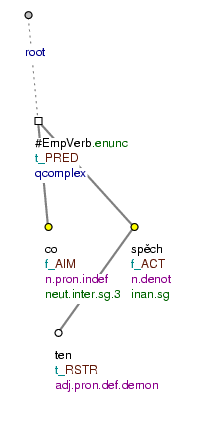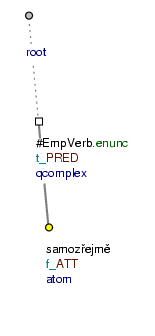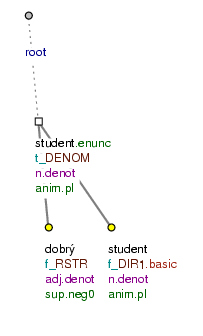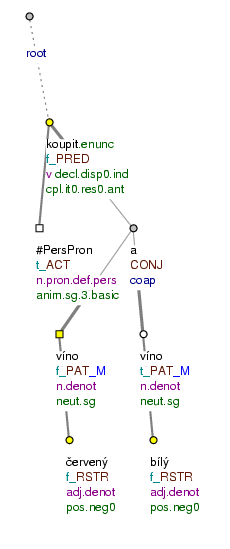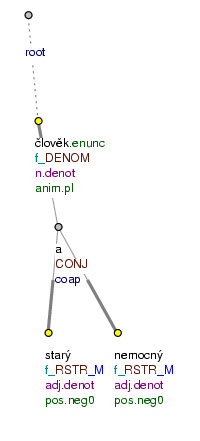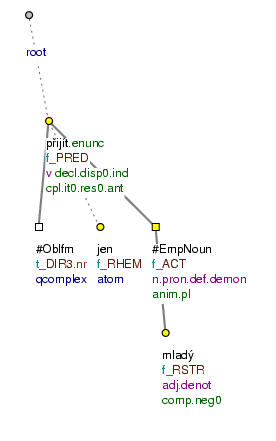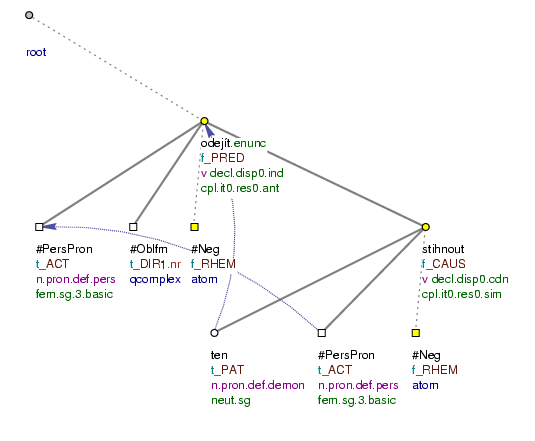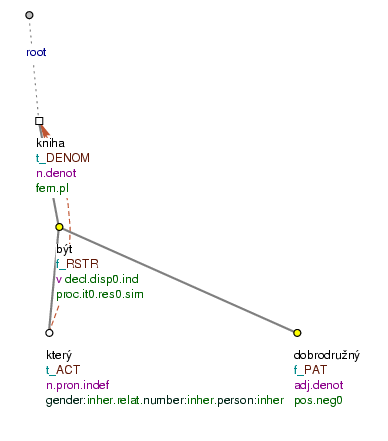Ellipsis of the governing elementEllipsis of the governing element is such a case of ellipsis in which the surface structure of the sentence lacks the expression governing those dependent modifications or clauses that require one by definition.
Such an absent governing element is always inserted into the tectogrammatical tree.
This concerns particularly the following cases, described below in separate subsections:
-
ellipsis of the governing verb (see Section 12.1.1, "Ellipsis of the governing verb"),
-
ellipsis of the governing noun (see Section 12.1.2, "Ellipsis of the governing noun"),
-
ellipsis of the governing clause (see Section 12.1.3, "Ellipsis of the governing clause"),
-
ellipsis of the governing node (necessary for representing the meaning properly) with certain special constructions (see Section 12.1.4, "Ellipsis of the governing element with some special constructions").
If a clause interpreted as verbal (for details see Section 4, "Verbal and non-verbal clauses") lacks its governing verb, the way of representing the ellipsis differs depending on whether it is a case of textual (see Section 12.1.1.1, "Textual ellipsis of the governing verb"), or grammatical ellipsis (see Section 12.1.1.2, "Grammatical ellipsis of the governing verb").
In those cases in which it is clear (and possible to find in the text) which verb has been omitted in the surface structure of the sentence (i.e. in the cases of textual ellipsis), a new node is inserted into the structure in place of the missing verb, namely a copy of the node representing the same lexical unit as the omitted element.
Such a copied node for the governing verb is always assigned a valency frame. Insertion of non-expressed valency modification into the sentence follows the rules in Section 12.2, "Ellipsis of the dependent element".
Cf.:
-
(Jirka navštívil Marii.) Honza Jiřinu (=lit. (George visited Mary.) John Henriette).
= (Jirka navštívil Marii.) Honza navštívil Jiřinu. (=lit. (George visited Mary.) John visited Hentriette.)
The governing verb navštívit (=to visit) is subject to textual ellipsis in the second sentence. The node representing the verb navštívit will be copied from the previous sentence (from the previous tectogrammatical tree) into the position of the elided verb. Cf. Fig. 6.199.
Another example:
Jirka prozradil, že on navštívil Marii a Honza { navštívit} Jiřinu. (=lit. George disclosed, that he visited Mary and John {visited} Henriette.) Fig. 6.200
Negation. It is necessary to pay attention to the negation of the original and copied nodes. The node for syntactic negation (t_lemma=#Neg; viz Section 13, "Modality and negation") is not copied, but rather a newly established node for syntactic negation is inserted if necessary. Cf.:
-
Pavel nepřinesl nic, Hanka čokoládu. (=lit. Paul brought nothing, Hanna chocolate.)
= Pavel nepřinesl nic, Hanka přinesla čokoládu. (=Paul brought nothing, Hanna brought chocolate.)
The governing verb přinést (=to bring) is subject to textual ellipsis in the second clause. The node representing the verb přinést (=to bring) will be copied from the previous clause (from the previous subtree) into the position of the elided verb. No node for syntactic negation will be inserted under the copied node.
-
V sobotu pracovali všichni, ale v neděli nikdo. (=lit. On Saturday worked everyone, but on Sunday nobody.)
= V sobotu pracovali všichni, ale v neděli nepracoval nikdo. (=lit. On Saturday worked everyone, but on Sunday not_worked nobody.)
The governing verb nepracovat (=not_to_work) is subject to textual ellipsis in the second clause. The node representing the verb pracovat (=to_work) will be copied from the previous clause (from the previous subtree) into the position of the elided verb. A node representing syntactic negation will be inserted under the copied node.
Textual ellipsis of multi-word predicates. If a multi-verb predicate, represented by two nodes, is subject to textual ellipsis (see Section 9, "Multi-word predicates"), both nodes representing the multi-word predicate are copied into the position of the omitted element. Therefore:
-
if a verbal phraseme is subject to textual ellipsis (see Section 8.2, "Verbal idioms"), both the node representing the governing part of the verbal phraseme and the node representing its dependent part (with the
DPHRfunctor) are copied into relevant the position. For example:-
(Jirkovi běhá mráz po zádech.) Honzovi také. (=lit. (To_George runs frost over shoulders.) To_John too.)
= (Jirkovi běhá mráz po zádech.) Honzovi také běhá mráz po zádech. (=lit. (To_George runs frost over shoulders.) To_John also runs frost over shoulders.)
The governing verbal phraseme běhá mráz po zádech (=lit. runs frost over shoulders) is subject to textual ellipsis in the second sentence. Both the node representing the governing verb běhat (run) and the node representing the dependent part of the phraseme mráz po zádech (frost over shoulders), with the
DPHRfunctor, will be copied into the relevant position.
-
-
if a complex predicate is subject to textual ellipsis (see Section 9.3, "Complex predicates"), both the node representing the verbal part of the complex predicate and the node representing its nominal part (with the
CPHRfunctor) are copied into the relevant position. For example:-
(Jirka má zájem studovat.) Honza také. (=lit. (George has interest to_study.) John too.)
= (Jirka má zájem studovat.) Honza má také zájem studovat. (=lit (George has interest to_study.) John has also interest to_study.)
The complex predicate mít zájem (to_have_interest) is subject to textual ellipsis in the second sentence. Both the node representing the governing verb mít and the node representing the nominal part of the phraseme plán (=plan) (with the
CPHRfunctor) will be copied into the position of the omitted complex predicate.
-
-
if a verbo-nominal predicate is subject to textual ellipsis (see Section 2.1.3, "Copula "být" (verbonominal predicate)"), both the node representing the copula verb být (=to_be) and the node representing the non-verbal part of the verbo-nominal predicate (with the
PATfunctor) are copied into the relevant position in the tree. For example:-
(Jirka je veselý.) Honza také. (=lit. (George is jolly.) John too.)
= (Jirka je veselý.) Honza je také veselý. (=lit. (George is jolly.) John is also jolly.)
The verbonominal predicate být veselý (=to_be_jolly) is subject to textual ellipsis in the second sentence. Both the node representing the copula verb být (=to_be) and the node representing the non-verbal part of the verbonominal predicate veselý (=jolly) (with the
PATfunctor) will be copied into the position of the omitted verbonominal predicate in the tree .
NB! There are some exceptional cases (comparative constructions) where the nonverbal part of the verbonominal predicate is not copied, but rather a newly established node with t-lemma
#Someis inserted into the structure (for details see Section 4, "Constructions with the meaning of "comparison"").NB! Due to the fact that we represent predicates like být veselý a šťastný (=lit. to_be jolly and happy) as a single verbonominal predicate with its nonverbal parts coordinated, it is necessary to copy all the nodes if such a predicate is subject to textual ellipsis: i.e. to copy the node representing the copula být (=to_be), the node representing the root of the paratactic structure as well as the nodes representing the coordinated nonverbal parts.
-
-
if a modal predicate represented by two nodes (see Section 9.1.1, "Modal predicates") is subject to textual ellipsis, both the node representing the modal verb and the node representing the infinitive of the lexical (full) verb (with the
PATfunctor) are copied into the relevant position in the tree. For example:-
(Jirka nemůže nepřijít) Honza také. (=lit. (George cannot not_to_come.) John too.)
= (Jirka nemůže nepřijít) Honza také nemůže nepřijít. (=lit. (George cannot not_to_come.) John also cannot not_to_come.)
The modal predicate nemůže nepřijít (=cannot not_to_come) is subject to textual ellipsis in the second sentence. Both the node representing the modal verb moci (=can) and the node representing the infinitive přijít (=come) (with the
PATfunctor) will be copied into the position of the omitted modal predicate.For more on modal predicates see Section 9.1.1, "Modal predicates".
-
!!! The analysis involving copying all the nodes representing the multi-word predicate has not been introduced for phase, quasi-phase and quasi-modal predicates. In those cases only the governing part is copied - if the predicate is subject to textual ellipsis - and the dependent part of the predicate is represented according to the rules in Section 12.2, "Ellipsis of the dependent element".
Textual ellipsis of the full verb with complex verb forms (the modal or auxiliary verb is not elided). Also those cases of ellipsis are considered textual ellipsis in which the full (lexical) verb is elided but the modal or auxiliary verb (forming a single predicate with it) stays in place . Cf.:
-
(Budeš se učit?) Budu. (=lit. (Will you learn?) (I) will.)
= (Budeš se učit?) Budu se učit. (lit. (=Will you learn?) (I) will REFL learn.)
The lexical verb učit se (=to_learn) is subject to textual ellipsis in the second sentence. The node representing the verb učit se (=to_learn) is copied from the previous sentence (from the previous tectogrammatical tree) into the relevant position. The whole predicate budu se učit (=I will learn) is represented by a single node (copied in this case). The meaning of the auxiliary is encoded in the values of the appropriate grammatemes (see Chapter 5, Complex nodes and grammatemes). Cf. Fig. 6.201.
-
(Měl bys už cvičit?) Měl bych. (=lit. (Should you already exercise?) (I) should -.)
= (Měl bys už cvičit?) Měl bych cvičit. (=lit. (Should you already exercise?) (I) should - exercise.)
The lexical verb cvičit (=to_exercise) is subject to textual ellipsis in the second sentence. The node representing the verb cvičit (=to_exercise) is copied from the previous sentence (from the previous tectogrammatical tree) into the position of the elided verb. The whole prodicate měl bych cvičit (=I should exercise) is represented by a single node (copied in this case). The meanings of the modal and auxiliary verbs are represented by the grammateme values (see Chapter 5, Complex nodes and grammatemes).
Another example:
(Musíš už jít?) <Musím> { jít} (= Must (you) already go?) (I) must {to_go}) . Fig. 6.202
Figure 6.199. Textual ellipsis of the governing verb
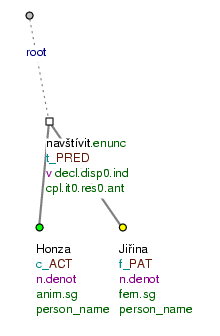
(Jirka navštívil Marii.) Honza Jiřinu. (=lit. (George visited Mary.) John Henriette.)
Figure 6.200. Textual ellipsis of the governing verb
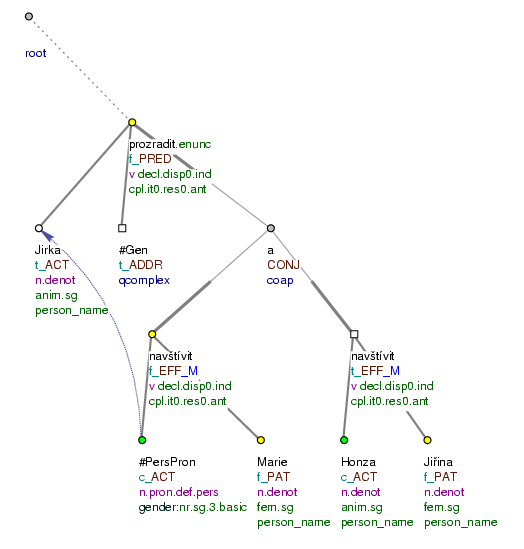
Jirka prozradil, že on navštívil Marii a Honza Jiřinu. (=lit. George disclosed, that he visited Mary and John Henriette.)
Figure 6.201. Textual ellipsis of the governing verb
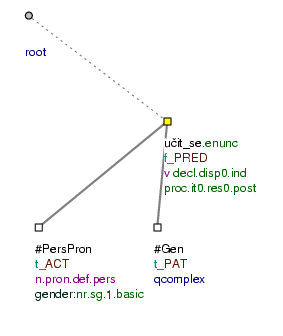
(Budeš se učit?) Budu. (=lit. (Will you learn?) (I) will.)
Figure 6.202. Textual ellipsis of the governing verb
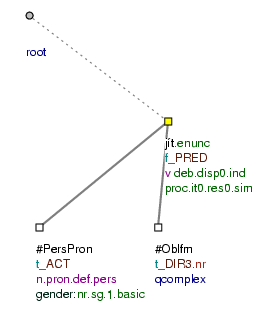
(Musíš už jít?) Musím. (=lit. (Must (you) already go?) (I) must.)
NB! We only copy the node representing the governing verb. The nodes representing its dependent modifications are not copied, they are represented by creating new nodes with t-lemma substitutes according to the rules stated here in Section 12.2, "Ellipsis of the dependent element".
Omitted dependent modifications of the governing verb are only copied if they are themselves governing nodes (and their dependent nodes are not elided). Cf.:
-
(Petr opravuje auto.) Jirka také. (=lit. (Peter repairs car.) George too.)
= (Petr opravuje dědovo auto.) Jirka také opravuje auto. (=lit. (Peter repairs grandfather's car.) George also repairs a_car.)
The governing verb opravovat (=to_repair) is subject to textual ellipsis in the second sentence. The node representing the verb opravovat (=to_repair) is copied from the previous sentence (from the previous tectogrammatical tree) into the appropriate position. The omitted Patient of the verb (auto (=car)) is not copied, instead, a newly established node with the t-lemma substitute
#PersPronis inserted into the structure (and its coreferential relation to the node representing the expressed Patient in the previous sentence is marked in the tree). -
(Petr opravuje dědovo auto.) Jirka otcovo. (=lit. (Peter repairs grandather's car.) George father's.)
= (Petr opravuje dědovo auto.) Jirka opravuje otcovo auto. (=lit. (Peter repairs grandfather's car.) George repairs father's car.)
The governing verb opravovat (=to_repair) is subject to textual ellipsis in the second sentence. The node representing the verb opravovat (=to_repair) will be copied from the previous sentence (from the previous tectogrammatical tree) into the appropriate position. The elided Patient (auto (=car)) will also be copied, as it simultaneously serves as the governing node of the expressed modification otcovo (=father's).
-
(Petr má plán studovat matematiku.) Jirka také. (=lit. (Peter has a_plan to_study mathematics.) George too.)
= (Petr má plán studovat matematiku.) Jirka má také plán studovat matematiku. (=lit. (Peter has a_plan to_study mathematics.) George has also a_plan to_study mathematics.)
The complex predicate mít plán (=to have a plan) is subject to textual ellipsis in the second sentence. Both the node representing the governing verb mít (=to have) and the node representing the nominal part of the phraseme plán (=plan) (with the
CPHRfunctor) will be copied into the position of the omitted complex predicate. The omitted Patient of the nominal part of the predicate (studovat (=to study)) will not be copied, instead, a newly established node with the t-lemma substitute#PersPronis inserted (and its coreferential relation to the node representing the expressed Patient in the previous sentence is marked in the tree). -
(Petr má plán studovat matematiku / v Brně.) Jirka fyziku / v Praze. (=lit. (Peter has a_plan to_study mathematics / in Brno.) George physics / in Prague.)
= (Petr má plán studovat matematiku.) Jirka má plán studovat fyziku / v Praze. (=lit. (Peter has a_plan to_study mathematics.) George has a_plan to_study physics / in Prague.)
The complex predicate mít plán (=to have a plan) is subject to textual ellipsis in the second sentence. Both the node representing the governing verb mít (=to have) and the node representing the nominal part of the phraseme plán (=plan) (with the
CPHRfunctor) will be copied into the position of the omitted complex predicate. The omitted Patient of the nominal part of the predicate (studovat (=to study)) will also be copied, as it simultaneously serves as the governing node of the expressed modification fyzika / v Praze (=physics / in Prague).
Grammatical ellipsis of the governing verb comprises all those cases in which the verb is not expressed in a clause interpreted as verbal (see Section 4, "Verbal and non-verbal clauses") and, at the same time, it is not textual ellipsis of the governing verb, i.e. the verb cannot be recovered from the context (these are constructions with the so-called empty verb; see Section 4.1, "Verbal clauses").
In the case of grammatical ellipsis of the governing verb, a newly established node with the t-lemma substitute #EmpVerb (empty verb) is inserted into the appropriate position. Cf.:
-
Nač {
#EmpVerb.PRED} ten spěch? (=lit. What_for {#EmpVerb} the haste?)The clause Nač ten spěch? (=lit. What_for the haste?) is interpreted as verbal. If it is not a case of textual ellipsis, the position of the absent governing predicate will be filled in by a node with the t-lemma substitute
#EmpVerb. Cf. Fig. 6.203.
No valency frame is assigned to the empty verb. Nodes dependent on the empty verb follow the rules in Section 12.2, "Ellipsis of the dependent element".
More examples:
Zeptal se: Nač {#EmpVerb.PAT} ten spěch? (=lit. (He) asked REFL: What_for {#EmpVerb} the haste?) Fig. 6.204
{#EmpVerb.PRED} Samozřejmě. (=lit. {#EmpVerb} Of_course.) Fig. 6.205
Figure 6.204. Grammatical ellipsis of the governing verb
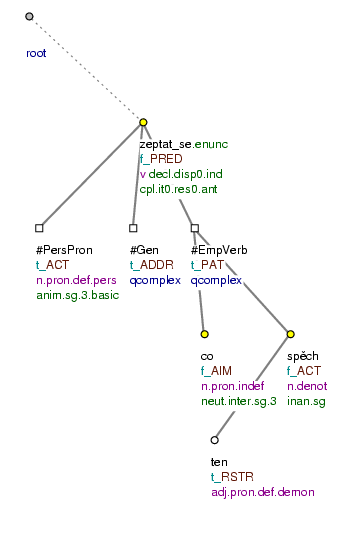
Zeptal se: Nač ten spěch? (=lit. (He) asked REFL: What_for the haste?)
Grammatical ellipsis of the governing verb - special cases. The empty verb is also used in the following cases:
-
transgressive constructions - with the transgressive omitted - of the type "seděl hlavu skloněnou (=lit. (he) was_sitting (his) head bowed)".
For details see Section 10.2.2, "Predicative complement expressed by a transgressive (gerund)".
-
the empty verb as the governing node of a subtree representing direct speech.
A node for the empty verb represents the non-expressed transgressive or infinitive of the verb of saying introducing the direct speech.
For details see Section 3.1.1.1, "Specific constructions in which direct speech is represented as an argument of the verb".
-
the empty verb as the effective root of the direct speech consisting only of a vocative or interjectional clause.
For details see Section 3, "Direct speech".
If adjectival modifications lack their governing noun in the surface structure, a new node for the governing noun is always inserted into the tectogrammatical tree structure. The annotation differs depending on whether it is textual (see Section 12.1.2.1, "Textual ellipsis of the governing noun") or grammatical ellipsis (see Section 12.1.2.2, "Grammatical ellipsis of the governing noun").
For a discussion on the distinction between syntactic (semantic) nouns and syntactic (semantic) adjectives, see Section 1, "Noun vs. adjective".
The following cases are not considered to be ellipsis of the governing noun: the adjective is:
-
in the Patient or Effect position and it agrees with another valency modification (this is a case of a predicative complement-like position):
Examples:
Zůstal spokojený.
PAT(=lit. (He) remained content.)Pokládali ho za mrtvého.
EFF(=lit. (They) considered him for dead.) -
in the position of the non-verbal part of a verbonominal predicate (see Section 2.1.3, "Copula "být" (verbonominal predicate)"):
Example:
To je hloupé.
PAT(=It is silly.) -
in the position of a predicative complement (
COMPL; see Section 10, "Predicative complement (dual dependency)").Example:
Pavel spí jako zabitý.
COMPL(=lit. Paul sleeps like killed.)
The node for the governing noun for syntactic adjectives in these positions is not inserted to the tectogrammatical tree.
Exception: An exception are those cases in which a position from the list above is occupied by two (or more) adjectives that modify the same noun (in a recursive fashion). Then the node representing the governing noun is inserted into the tectogrammatical tree. For example:
-
Jediné možné je konsensuální řešení. (=lit. Only possible is consensual solution.)
= Jediné možné řešení je konsensuální řešení. (=lit. Only possible solution is consensual solution.)
-
Olomoucká kolekce grafiky je třetí největší u nás. (=lit. Olomouc collection of_graphics is the_third largest in our_country.)
= Olomoucká kolekce grafiky je třetí největší kolekce u nás. (=lit. Olomouc collection of_graphics is the_third largest collection in our_country.)
-
Olomoucká kolekce grafiky zůstane třetí největší u nás. (=lit. Olomouc collection of_graphics will_remain the_third largest in our_country.)
= Olomoucká kolekce grafiky zůstane třetí největší kolekcí u nás. (=Olomouc collection of_graphics will_remain the_third largest collection in our_country.)
If it is clear (and possible to find in the text) which noun has been omitted in the surface structure of the sentence (i.e. it is a case of textual ellipsis), a copy of the node representing the same lexical unit as the omitted element is inserted into the appropriate position.
Cf.:
-
Modré pantofle jsou maminky, zelené jsou bratrovy. (=lit. Blue slippers are mother's, green are brother's.)
= Modré pantofle jsou maminky, zelené pantofle jsou bratrovy. (=lit. Blue slippers are mother's, green slippers are brother's )
The noun pantofle (=slippers), governing the expressed adjective zelený (=green), is subject to textual ellipsis in the second clause. The node representing the noun pantofle (=slippers) is copied from the previous text (from the previous subtree) into the appropriate position. Cf. Fig. 6.206.
Another example:
nejlepší { student} ze studentů (=lit. best {student} of students) Fig. 6.207
Figure 6.206. Textual ellipsis of the governing noun
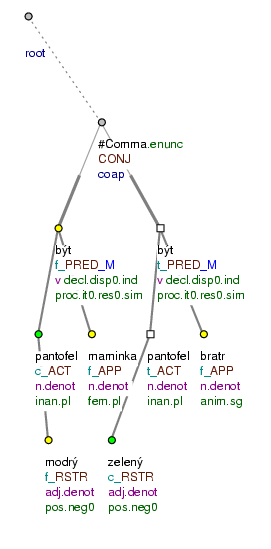
Modré pantofle jsou maminky, zelené bratrovy. (=Blue slippers are mother's, green borother's.)
Textual ellipsis of the governing noun in constituent coordination. Ellipsis of the noun governing a syntactic adjective also includes cases of ellipsis in constituent coordination (parataxis of sentence parts; see Section 6.1.2, "Parataxis of sentence parts, parataxis of clauses and mixed parataxis"). These are the cases in which two or more entities referred to by the same noun are in coordination (or paratactic structure) but the noun is expressed only once.
However, it is necessary to consider such cases carefully, not to misjudge the cases in which in fact only one entity is modified by two or more modifiers - it is crucial that there be two or more different entities. Then, a copy of the expressed noun is inserted into the subtree representing the conjunct with the ellipsis. Cf.:
-
modrý a červený inkoust (=lit. blue and red ink)
= modrý inkoust a červený inkoust. (=blue ink and red ink)
The noun inkoust (=ink) governing the expressed adjective modrý (=blue) is subject to textual ellipsis (and these are two different objects, not just one). The node representing the expressed noun inkoust (=ink) is copied into the appropriate position.
The same applies to those cases when the modified noun is in plural, i.e:
-
modré a červené inkousty (=lit. blue and red inks)
= modré inkousty a červené inkousty. (=blue inks and red inks.)
More examples:
červené { víno} a bílé víno (=red {wine} and white wine) Fig. 6.208
střední {Evropa} a východní Evropa (=lit. Central {Europe} and Eastern Europe)
ministerstva práce a sociálních věcí a {ministerstvo} zdravotnictví (=lit. ministries of_labour and social affairs and {ministry} of_health)
Where the semantics is ambiguous, we prefer the simpler structure: the paratactic structure is represented in such a way as if there was only one entity; the coordination of adjectives depends on the node representing the expressed noun; e.g.:
staří a nemocní lidé (=lit. old and ill people) Fig. 6.209
obchody s dámskou {konfekce} a pánskou konfekcí (=lit. shops with female {confection} and male confection)
If the missing governing noun is not clearly recoverable from the context (grammatical ellipsis), the ellipsis is represented by a newly established node with the t-lemma substitute #EmpNoun. Cf.:
-
Přišli jen {
#EmpNoun.ACT} mladší. (=lit. Came only {#EmpNoun} younger.)The noun governing the expressed adjective mladší (=younger) is not expressed in the clause. A newly established node with the t-lemma substitute
#EmpNounwill be inserted into the appropriate position (if it is not a case of textual ellipsis in fact). Cf. Fig. 6.210.
Another example:
Uvolněte místa {#EmpNoun.ACT} starším. (=lit. Free seats {#EmpNoun} for_older.)
If a clause interpreted as dependent (see Section 4, "Verbal and non-verbal clauses" and Section 5, "Dependent verbal clauses") is not expressed in the surface form of the sentence, a new node representing its governing clause is always inserted into the tectogrammatical tree. The annotation differs depending on whether it is a case of textual or grammatical ellipsis and whether the dependent clause is a relative, content or adverbial clause.
NB! Also those cases of dependent clauses are included in this type of ellipsis, which are regularly used alone.
For details on content, adverbial and relative clauses see Section 5, "Dependent verbal clauses".
Ellipsis of the clause governing a content or adverbial dependent clause. Ellipsis of the clause governing a content or adverbial dependent clause is represented in a similar way as ellipsis of the governing verb. A newly established node is inserted into the position of the governing node of the dependent clause, following the rules in Section 12.1.1, "Ellipsis of the governing verb" (the node is either a copy of a verb from the preceding or following sentences, or, if it is not a case of textual ellipsis, it has the t-lemma substitute #EmpVerb). The effective root of the dependent clause is assigned a functor corresponding to the mening of the subordinating conjunction.
Cf.:
-
Co {
#EmpVerb.PRED} <když> narazí.CONDna padělek? (=lit. What {#EmpVerb} if (he) encounters to a_counterfeit?)The clause governing the dependent conditional clause is absent. Therefore, a new node with the t-lemma substitute
#EmpVerbis inserted into the position of the node governing the effective root of the dependent clause.
More examples:
(Neodešla. (=lit. (She) did_not_leave.))
{odejít (=to_leave).PRED} <Protože> by to nestihla.CAUS (=lit. Because (she) would it not_make.) Fig. 6.211
(Nebudu se s tebou o tom bavit. (=lit. (I) will_not myself with you about it talk.))
{bavit.PRED (=talk)} Aspoň <pokud> budeš.COND takový. (=lit. At_least if (you) will_be like_that.)
A co { stát_se.PRED} <kdyby> Maastricht v neděli neprošel.COND ? (=lit. And what {to_happen} if Maastricht on Sunday would_not_pass?) (Evropa s úlevou vítá výsledek galského referenda, pro samé ulehčení si však zapomíná zodpovědět důležitou otázku. Co by se stalo, kdyby ve Francii Maastricht neprošel?) (=lit. Europe with relief welcomes the_result of_Gaelic referendum, for all the_relief REFL however forgets to_answer an_important question. What would REFL happen, if in France Maastricht would_not _pass?))
Ellipsis of the clause governing a relative (dependent) clause. Ellipsis of the clause governing a relative clause is represented in a similar way as ellipsis of the governing noun. A newly established node is inserted into the position of the governing node of the dependent clause (i.e. its effective root node), following the rules in Section 12.1.2, "Ellipsis of the governing noun" (the node is either a copy of a noun from the preceding or following sentences, or, if it is not a case of textual ellipsis, it has the t-lemma substitute #EmpNoun). The effective root of the dependent clause is assigned the RSTR functor.
Example:
(Čtu všechny knihy. (=I read all books.))
{kniha.DENOM (=book)} Které jsou.RSTR dobrodružné. (=lit. Which are adventurous.) Fig. 6.212
NB! Ellipsis of the clause governing a relative clause can cooccur with ellipsis of the governing verb. In such cases, both the node for the governing noun and the node for the governing verb are inserted into the tectogrammatical tree. Cf.:
-
Přijde o možnost získávat nesrovnatelně vyšší úroky, než jakými jsou úročeny srovnatelné vklady ostatních klientů. (=lit. (He) will_lose - opportunity to_gain incomparably higher interests, than by_which are charged comparable investments (of) other clients.)
= Přijde o možnost získávat nesrovnatelně vyšší úroky, než jsou úroky, jakými jsou úročeny srovnatelné vklady ostatních klientů. (=lit. (He) will_lose - opportunity to_gain incomparably higher interests, than are interests, by_which are charged comparable investments (of) other clients.)
A new node with the t-lemma substitute
#EmpVerbwill be inserted into the structure in the position of the governing verb of the (dependent) comparative clause (functor=CPR) ; this is not a case of textual ellipsis. At the same time, a copy of the node for the expressed noun úroky (=interests) will inserted into the position of the governing noun of the relative clause. The copied node will be assigned theACTfunctor and it will depend on the inserted empty verb node.
With certain more complex structures, some modifications always have to be present at the tectogrammatical level (for semantic reasons), whether they are expressed in the surface structure or not (this is a case of grammatical ellipsis). Hence, if such a modification is not present in the surface structure of the sentence, a newly established node with a t-lemma substitute is inserted into the tectogrammatical tree in its place. This concerns the following cases, which are described in more detail in separate sections:
-
ellipsis of the governing node in comparative constructions (a new node with the t-lemma substitute
#Equalis inserted; see Section 4, "Constructions with the meaning of "comparison""), -
ellipsis of the governing node in constructions with the meaning of a restriction (a new node with the t-lemma substitute
#Totalis inserted; see Section 6.1, "Meaning of "restriction""), -
ellipsis of the governing node in constructions with consecutive clauses (a new node with the t-lemma substitute
#AsMuchis inserted; see Section 7, "Constructions with a dependent consecutive clause"). -
insertion of a node with the t-lemma substitute
#Idphin identifying expressions (see Section 8, "Identifying expressions").
Some related issues:
-
insertion of a node with the t-lemma substitute
#Fornin foreign-language expressions (see Section 9, "Foreign-language expressions"). -
insertion of a node with the t-lemma substitute
#Separin paratactic structures (for more see Section 6, "Parataxis").
